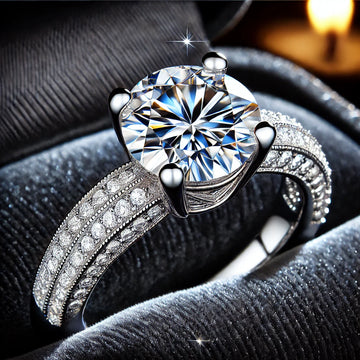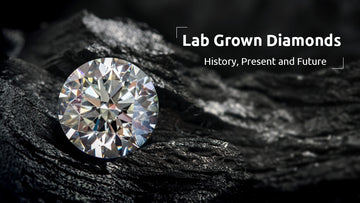Shine Bright with Lab-Grown Diamonds: A Modern Twist on Timeless Beauty
by Keyur Koshiya on Nov 27, 2024

The Rising Popularity of Lab-Grown Diamonds in the Global Market
Lab-grown diamonds are gaining prominence as a sustainable and ethical alternative to natural diamonds. The shift towards lab-grown diamonds is not just a passing trend but represents a significant shift in consumer preferences. As awareness grows about the environmental and social impacts of diamond mining, more and more consumers are opting for lab-grown diamonds as their preferred choice for fine jewelry and engagement rings.
https://ivevar.com/products/custom-moissanite-diamond-watch-for-women-by-ivevar-copy
Consumer Awareness and Preferences
In recent years, the rise of socially conscious and eco-friendly consumerism has driven a change in the way people purchase luxury goods. Consumers today are more informed and more willing to choose products that align with their values, especially when it comes to sustainability and ethics.
Lab-grown diamonds are seen as an answer to many of the ethical issues surrounding the mining of natural diamonds, such as labor exploitation and environmental damage. Many consumers are drawn to the idea that lab-grown diamonds are created in controlled environments, free from the ethical concerns associated with traditional diamond mining. As a result, the demand for these diamonds is growing rapidly, particularly among younger generations, who are more environmentally conscious.
One of the most significant benefits of lab-grown diamonds is their transparency. Unlike mined diamonds, which may be sourced from regions where conflict or unethical practices are common, lab-grown diamonds come with certificates detailing their origins and the processes they undergo. This level of transparency appeals to consumers who want to ensure that their purchase is ethically sourced and does not contribute to environmental harm.
Market Growth and Opportunities
The global lab-grown diamond market is expected to continue growing at an accelerated pace. According to recent industry reports, the market for lab-grown diamonds is forecasted to grow by over 20% annually for the next several years. A growing number of consumers, especially millennials and Generation Z, are becoming aware of the ethical and environmental benefits of choosing lab-grown diamonds over mined ones.
This surge in demand has prompted jewelry brands and retailers to expand their offerings of lab-grown diamonds. Big names in the jewelry industry are increasingly adding lab-grown diamonds to their collections, and some even offer them as the primary option for engagement rings. This shift is also evident in the luxury segment, where high-end designers are integrating lab-grown diamonds into their collections, making these diamonds more accessible to a broader audience.
Lab-grown diamonds are particularly appealing to price-sensitive consumers who still want a high-quality, beautiful diamond but at a fraction of the cost of natural diamonds. With lab-grown diamonds often costing 30%-40% less than mined diamonds of comparable size, cut, and clarity, they offer a more affordable option for those looking to purchase diamonds without compromising on quality.
Additionally, the fact that lab-grown diamonds can be produced in various colors (such as pink, blue, and green) and even custom-designed to suit personal preferences is also driving demand. These diamonds can be tailored to fit specific customer needs, whether it’s a certain size, shape, or color, offering a level of personalization that natural diamonds cannot match.
Technological Advancements in the Lab-Grown Diamond Industry
As the lab-grown diamond industry matures, advancements in technology are playing a crucial role in improving the quality and efficiency of diamond production. These innovations are not only reducing the cost of production but also enabling the creation of diamonds that are virtually indistinguishable from their natural counterparts.
Improvements in Diamond Quality
In the early stages of lab-grown diamond production, the focus was primarily on small, industrial-grade diamonds. These diamonds were primarily used for applications such as cutting tools and electronics. However, with advancements in technology, lab-grown diamonds are now being produced in larger sizes, with exceptional clarity and color.
CVD diamonds, in particular, have made great strides in terms of quality. The precision involved in the CVD process allows for the creation of diamonds that are virtually flawless, with minimal inclusions and a brilliant sparkle. The ability to produce high-quality, large diamonds has made lab-grown diamonds a viable option for engagement rings and fine jewelry, offering a competitive alternative to mined diamonds.
Enhancing Sustainability through Technology
Technology also plays a key role in making the production of lab-grown diamonds more sustainable. As the demand for lab-grown diamonds grows, the industry is focusing on improving the energy efficiency of production processes. For instance, many companies are turning to renewable energy sources to power their operations, reducing their carbon footprint. By investing in energy-efficient technologies and greener manufacturing processes, lab-grown diamonds are becoming increasingly eco-friendly.
In addition to reducing energy consumption, technological advancements have allowed for the use of more sustainable raw materials. The ongoing development of more sustainable practices means that lab-grown diamonds can be produced with a reduced environmental impact, addressing one of the most significant concerns surrounding traditional diamond mining.
The Role of Artificial Intelligence (AI) and Automation
Artificial intelligence (AI) and automation are also playing an increasing role in the production of lab-grown diamonds. AI-powered systems are being used to optimize the growth process, ensuring that diamonds are grown with the highest level of precision. This not only improves the quality of the diamonds but also makes the production process more efficient, reducing costs and production times.
Automation is helping to streamline the production process, allowing for greater consistency in the creation of diamonds. By minimizing human error and ensuring that each diamond is produced under optimal conditions, automation is contributing to the rise in high-quality lab-grown diamonds.
The Future of Lab-Grown Diamonds: Market Trends and Challenges
As lab-grown diamonds continue to gain traction, it’s important to consider the future direction of the industry. Several key trends are likely to shape the market in the years to come.
Rising Demand for Customization and Personalization
As consumers seek more unique and personal experiences, the demand for customized lab-grown diamonds is on the rise. Lab-grown diamonds are particularly well-suited for customization, as they can be designed to meet specific color, size, and shape preferences. Jewelry brands are beginning to offer more bespoke services, allowing customers to design their perfect diamond ring or piece of jewelry from scratch.
Additionally, lab-grown diamonds can be more easily manipulated to create unique cuts or colors that are rarely found in natural diamonds. The ability to create a truly one-of-a-kind piece of jewelry is one of the major advantages that lab-grown diamonds offer over mined diamonds. As consumer demand for personalized luxury continues to grow, the custom lab-grown diamond market is expected to expand rapidly.
Ethical and Environmental Considerations
The growing awareness of environmental and ethical issues surrounding the diamond industry will continue to drive demand for lab-grown diamonds. Many consumers are concerned about the impact of diamond mining on local communities, ecosystems, and wildlife. Lab-grown diamonds offer an ethical alternative, as they are produced without exploiting workers or harming the environment.
Lab-grown diamonds are also appealing to consumers who are looking for a more sustainable option. The reduced environmental impact of producing lab-grown diamonds compared to mined diamonds is a key selling point. As the global focus on sustainability intensifies, lab-grown diamonds are well-positioned to play a major role in the future of the luxury goods market.
Challenges for the Lab-Grown Diamond Industry
While lab-grown diamonds offer a range of benefits, there are also challenges that the industry will need to address. One of the key challenges is consumer education. Despite the growing popularity of lab-grown diamonds, many consumers still have misconceptions about their quality and value. For instance, some people may still view lab-grown diamonds as inferior to natural diamonds, despite the fact that they are chemically identical.
Another challenge is the potential for market saturation. As more companies enter the lab-grown diamond space, there may be increased competition and price pressures. Additionally, as the technology for producing lab-grown diamonds continues to improve, the supply of diamonds may increase, potentially affecting prices.
Increased Competition from Natural Diamonds
Despite the growing market for lab-grown diamonds, the traditional diamond industry still enjoys strong brand recognition and consumer trust. Many consumers continue to view natural diamonds as a symbol of luxury, prestige, and permanence. For some, the rarity of natural diamonds is a key selling point, and they may be reluctant to embrace lab-grown diamonds as a substitute.
In response to the rise of lab-grown diamonds, some natural diamond companies are focusing on enhancing the uniqueness and authenticity of their diamonds through marketing campaigns. For instance, some brands are emphasizing the emotional connection that consumers have with natural diamonds and the symbolic meaning associated with their purchase.
Conclusion
The lab-grown diamond industry is rapidly evolving, offering an innovative, sustainable, and affordable alternative to traditional mined diamonds. As consumer preferences shift towards ethical and eco-friendly products, lab-grown diamonds are poised to play a significant role in the future of fine jewelry, fashion, and beyond. With advances in technology, customization options, and increasing demand, lab-grown diamonds are gaining widespread acceptance and disrupting the traditional diamond industry.
The future of lab-grown diamonds is bright, with further advancements in production processes and a growing demand for transparent, sustainable luxury goods. As the industry continues to evolve, lab-grown diamonds are expected to become even more mainstream, reshaping the perception of diamonds as a luxury commodity and making them more accessible to a broader audience. The lab-grown diamond revolution has just begun, and its impact on the jewelry and luxury industries will be felt for years to come.

 Engagement Ring
Engagement Ring  Anniversary Rings
Anniversary Rings Solitaire Rings
Solitaire Rings Halo Rings
Halo Rings Men's Ring
Men's Ring Toi Moi Ring
Toi Moi Ring Three Stone Rings
Three Stone Rings Nature Inspired Rings
Nature Inspired Rings Rose Cut Diamond Rings
Rose Cut Diamond Rings Fancy Color Rings
Fancy Color Rings Antique Cut Diamond Rings
Antique Cut Diamond Rings Wedding rings
Wedding rings All Lab Grown Diamond Ring
All Lab Grown Diamond Ring Engagement Ring
Engagement Ring  Three Stone Rings
Three Stone Rings Daily Wear
Daily Wear Fancy Color Rings
Fancy Color Rings Antique Cut Diamond Rings
Antique Cut Diamond Rings Earrings
Earrings Bracelet
Bracelet Pendent
Pendent Necklace
Necklace Rings
Rings Earrings
Earrings All Rainbow Collection
All Rainbow Collection Tennis chain
Tennis chain Custom Pendent
Custom Pendent Custom Ring
Custom Ring Custom Teeth Grillz
Custom Teeth Grillz Round
Round Oval
Oval Cushion
Cushion Marquise
Marquise Pear
Pear Emerald
Emerald Heart
Heart Princess
Princess Rose Cut
Rose Cut Radiant
Radiant Antique Cut
Antique Cut Regular Cut
Regular Cut Cushion
Cushion Men's Ring
Men's Ring Bridal Sets
Bridal Sets




